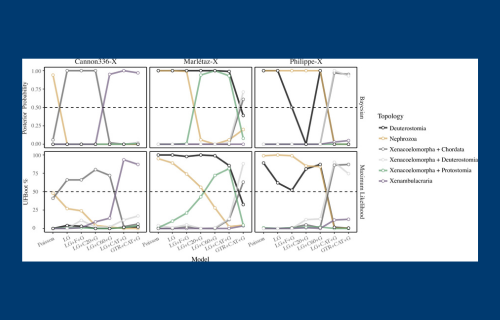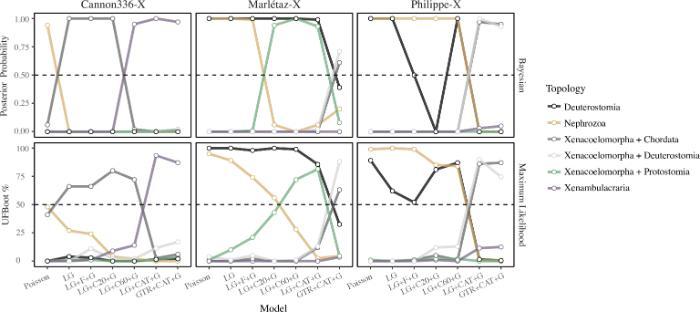Avoiding phylogenetic errors in proposing a novel set of relationships for Xenacoelomorpha
Friday, 20 September, 2024
Share

Congratulations to UCD School of Medicine's Dr Anthony Redmond, whose first paper from his lab has been published in The Royal Society Publishing.
The relationships between Xenacoelomorpha and other bilaterians has been a hotly debated topic in phylogenomics as it has implications for early bilaterian evolution. However, this has meant many studies have not closely considered internal xenacoelomorph relationships.
The two longest branching lineages within Xenacoelomorpha (Nemertodermatida and Acoela) are typically recovered as sister groups in phylogenomics, but some recent studies, when attempting to minimize phylogenetic errors have instead recovered, but not reported a 'Xenacoela' clade.
In this study, Dr Redmond performed extensive data filtering with the aim of minimising propensity for long-branch attraction. When the best fitting models are applied to this filtered data there is clear evidence in Bayesian and ML for this alternative clade, which Dr Redmond named Xenacoela.
A variety of analyses and simulations further evidence Xenacoela, suggesting Acoelomorpha is a very severe long-branch attraction artefact. These analyses also suggest Xenacoelomorpha are not the sister group to other Bilaterians, but don't resolve their closest relatives.
Acoelomorph flatworm monophyly is a long-branch attraction artefact obscuring a clade of Acoela and Xenoturbellida
 Abstract
Abstract
Acoelomorpha is a broadly accepted clade of bilaterian animals made up of the fast-evolving, morphologically simple, mainly marine flatworm lineages Acoela and Nemertodermatida. Phylogenomic studies support Acoelomorpha’s close relationship with the slowly evolving and similarly simplisticXenoturbella, together forming the phylum Xenacoelomorpha. The phylogenetic placement of Xenacoelomorpha amongst bilaterians is controversial, with some studies supporting Xenacoelomorpha as the sister group to all other bilaterians, implying that their simplicity may be representative of early bilaterians. Others propose that this placement is an error resulting from the fast-evolving Acoelomorpha, and instead suggest that they are the degenerate sister group to Ambulacraria.
Perhaps as a result of this debate, internal xenacoelomorph relationships have been somewhat overlooked at a phylogenomic scale.
In this paper, Dr Redmond employs a highly targeted approach to detect and overcome possible phylogenomic error in the relationship betweenXenoturbellaand the fast-evolving acoelomorph flatworms. The results indicate that the subphylum Acoelomorpha is a long-branch attraction artefact obscuring a previously undiscovered clade comprisingXenoturbellaand Acoela, which he names Xenacoela. The findings also suggest that Xenacoelomorpha is not the sister group to all other bilaterians.
This study provides a template for future efforts aimed at discovering and correcting unrecognised long-branch attraction artefacts throughout the tree of life.
To read the full paper, click (opens in a new window)here.